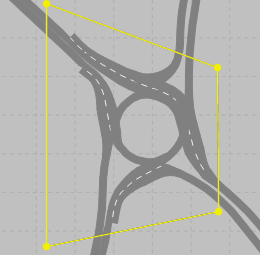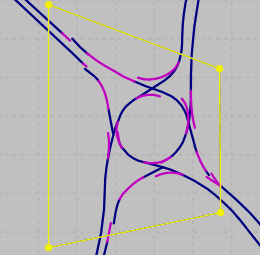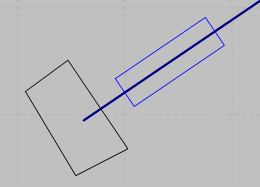Modeling nodes
The geometry of the road network is modeled in a very detailed manner in Vissim. This exactness is not necessary for the decision of a driver for a specific path through the network. The exact traffic routing at the node is not relevant; instead, the directions on the nodes which can be turned are relevant.
In order to reduce the complexity of the network model and therefore also the calculation time and memory required, you can identify parts of the network as nodes. These positions are at the minimum the positions in which the paths merge together, or the positions which branch out in different directions. Normally these are the network sections which represent a real intersection. Do not group larger network sections, containing multiple intersections, into a node.
Nodes for evaluations, dynamic assignment and mesoscopic simulation
You define nodes for evaluations and/or dynamic assignment in the Network editor. In the attributes of the node, you select what the node is to be used for: for evaluations and/or dynamic assignemnt and/or mesoscopic simulation.
Depending on the particularities of the network, a node can be used for evaluations, dynamic assignment and mesoscopic simulation. However, certain particularities of a network might require you to model additional nodes for mesoscopic simulation (Mesoscopic node-edge model).
You can also merge multiple intersections into one node for dynamic assignment, typically along a link sequence. If there is more than one turn relation from each node entrance to each node exit within this node, you can block the turn relations that you do not want vehicles to use. This can be useful, for example, if you want to ensure that the dynamic assignment in an interchange for the vehicles that are to travel straight ahead takes into account only the link sequence that leads straight through the interchange and not also the link sequence that leads back to the same link sequence via the ramps of the exits and entrances.
If your Vissim network contains roundabouts and you want to perform a dynamic assignment, you only need one node for each roundabout or complex intersection. For each of these nodes, select the attribute Use for dynamic assignment. It is not necessary to define a separate node for each conflict of two movements. Example file ..\Examples Demo\Roundabout Schenectady.US\Roundabout Schenectady.inpx:


Nodes at the boundary of a network
For dynamic assignment, nodes are required at the boundaries of the network where links in the Network editor begin or end. Example file ..\Examples Training\Dynamic Assignment \Detour\Detour.inpx:


|
|
Notes:
|
Superordinate topic:
Building an Abstract Network Graph
Information on editing:
Quick start guide Dynamic assignment
Selecting nodes, polygons or segments
Related topics:


